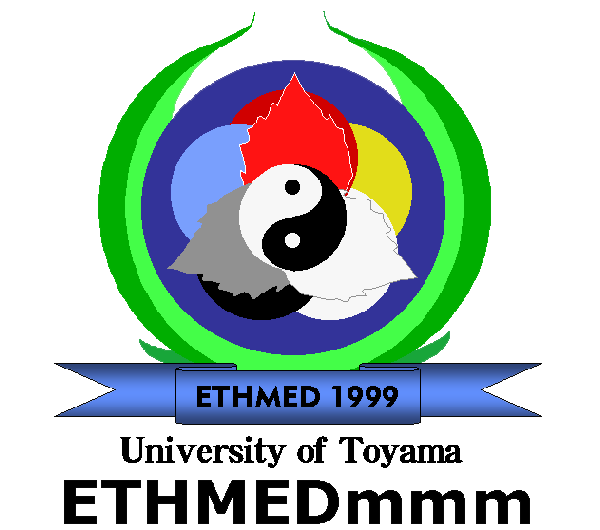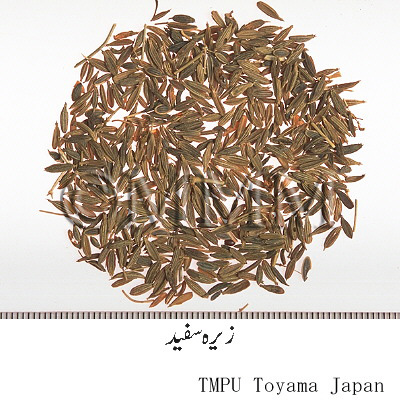Crude drug sample data base
※Click on the image to enlarge it.
The capital city, provincial capital city or the representative
location of its administrative area is indicated.
location of its administrative area is indicated.
Production area information
https://ethmed.toyama-wakan.net/img/pin_san.png
21.8311002
92.36863210000001
Collection information
People's Republic of Bangladesh,Bandarban District
https://ethmed.toyama-wakan.net/img/pin_nyu.png
Scientific information data base
| Crude drug name | Urudu name, English name | Zirah Safaid, Cumin | |||
|---|---|---|---|---|---|
| Arabic name / Persian name | Kammun / Kammun, Zirae-sufed | ||||
| crude drug image |
| ||||
| Original plant name | Cuminum cyminum Linn. | ||||
| Family name | Umbelliferae | ||||
| Used part | Fruits (seeds) | ||||
| Distribution area | It is extensively cultivated as a cold season crop on the plains and as summer crop on the hills in Northern India, Himalayas and the Punjab, Kashmir, Kumaon, Garhwal and Chamba. It is also found in Baluchistan; also imported from Iran and Asia Minor. | ||||
| Description | Cumin is of three kinds: (i) Zirah safaid (Cuminum cyminum), (ii) Zirah siyah (Carum carvi Linn.), black cumin. It is also called Kamun Kirmani. It is more frequently used than the other kinds and (iii) Kali ziri (Bunium persicum (Boiss) Fedt.), wild cumin. Odour - pleasant; taste - sweetish, pungent, acrid and fragrant. | ||||
| Function and properties | Cosmetics, Swellings, Ulcers, Head, Eye, Chest, Excretion. Aromatic, stomachic, carminative, astringent, useful in diarrhoea/diarrhea and as antidyspeptic; cooling desiccative, antiphlegmatic, diuretic and emmenagogue upto certain extent. | ||||
| Specific actions | Carminative. | ||||
| Frequency in use | Common. | ||||
| Common uses | Cosmetics: Washing with its water cleanses the face. Swellings: It is used in the form of a qairuti prepared with olive oil and the flour of broad bean in orchitis. Ulcers: Finely powdered cumin heals the wounds. Head: Inhalation of cumin powder with vinegar stops epistaxis. Eye: Powdered and applied in the eyes to remove plectrum and web-eye. The extract of wild cumin improves eyesight ad absorbs epiphora. Chest: Its oral intake with vinegar and water is useful in dyspnea. It is also useful for treating cold palpitation. Excretion: The wild cumin is particularly useful in cases of strangury, haematuria/hematuria, gripes and flatulence. It is digestive, increases appetite, prevents hiccup and constipative. Its distilled concoction proves effective against abdominal pains and acts as carminative. | ||||
| Side effect | It is emaciating and considered harmful for the lungs (on prolonged use). The cumin is considered to be useful in cases of insect bite. | ||||
| Medical system | Unani | ||||
| Traditional concept | Temperament | It is hot in the second and dry in the third degree (Avicenna and Kabiruddin). | |||
| Drug effect | Carminative. | ||||
| Dosage | 3 to 5gm. | ||||
| Substitute | Zeera siyah (Carum carvi Linn.), black caraway. | ||||
| Corrigent (corrective) | Katira (Cochlospermum religiosum (L.) Alston) and cold and moist eatable things. | ||||
| Important compound preparations | Jawarish Mastagi Kalan, Habb Ashkhar, Habb Pachlauna and Ma`jun Bawasir. | ||||
| References | Reference book Tips! | Glossary of Indian Medicinal Plants, 1956. Chopra, R.N., Nayar, S.L. and Chopra, I.C., Council of Scientific & Industrial Research, New Delhi. - New Edition (1996) National Institute Science Communication; Supplement p 84. Illustrated Manual of Herbal Drugs Used in Ayurveda, 1996. Sarin, Y.K., Council of Scientific & Industrial Research and Indian Council of Medical Research, New Delhi p 278. Indian Materia Medica, Vols. 1-2, 1976 (Repr. 1989). Nadkarni, A.K., Popular Prakashan Pvt. Ltd., Bombay Vol. 1, pp 408-410. Makhzanul-Mufradat (Khawasul Adviyah), Hakeem Kabiruddin, Daftar Al-Masih, Qarol Bagh, Delhi. pp 322-323. A Survey of Drugs, 1961 (2nd edi.). Wahid, A. K. and Siddiqui, H. H. Institute of History of Medicine and Medical Research, Delhi. pp 19-30. Dictionary of Economic Plants in India, 1996 (2nd Rep.). Singh, U; Wadhwani, A. M. and Johri B.M. Indian council of Agricultural Research, New Delhi. p 61. Al-Qanun Fil-Tibb. Avicenna. (English translation of the critical Arabic text), Book 2, 1998. Hameed, H. A. (editor), Dept. of Islamic Studies, Jamia Hamdard (Hamdard University), New Delhi. pp 398-399. Hamdard Pharmcopoeia of Eastern medicine, 1969. Said, H. M. (editor), The Times Press, Sadar Karachi. pp 91, 95, 97, 261-262. Indusyunic Medicine, 1997. Usmanghani, K., Saeed, A. and Alam, M. T. Department of Pharmacognosy, Faculty of Pharmacy, University of Karachi, Karachi. pp 192-193. | |||
| Remarks | The drug is described by all the Unani physicians. It is entered in the list of drugs used both in Unani and Ayurvedic Systems of Medicine. It is very much used in cookery as condiment. Essential oil is used in perfumery and for flavouring beverages. This oil also possesses anti-microbial activity. | ||||
| Last renewal date | 2024/03/19 | ||||



